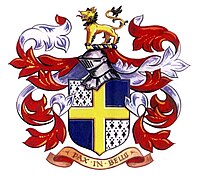D'Arcy Osborne, 12th Duke of Leeds
The Duke of Leeds | |
|---|---|
| Born | Francis D'Arcy Godolphin Osborne 16 September 1884 |
| Died | 20 March 1964 (age 79) |
| Occupation | Diplomat |

Francis D'Arcy Godolphin Osborne, 12th Duke of Leeds, KCMG (16 September 1884 – 20 March 1964), known before 1963 as Sir D'Arcy Osborne, was a British diplomat.
Early life and career
Osborne was the son of Sidney Francis Godolphin Osborne and of Margaret Dulcibella, née Hammersley. Through his father, he was the great-great-grandson of Francis Osborne, 5th Duke of Leeds, Foreign Secretary between 1783 and 1791.
He was educated at Haileybury, before joining HM Diplomatic Service. In about 1919 or 1920, Osborne met Lady Elizabeth Bowes-Lyon, the future Queen Elizabeth, with whom he maintained a life-long friendship.
He was British Minister at Washington (the deputy head of the British mission to the United States) between 1931 and 1935.
Minister to the Holy See
Osborne was Envoy Extraordinary and Minister Plenipotentiary to the Holy See 1936–1947.[1] His appointment came on the heels of Cardinal Secretary of State Pacelli's (future Pope Pius XII) complaints of the short tenure of British Ministers to the Vatican; in fact, Osborne himself waited six months after his appointment before arriving in Rome.[2]
When Italy declared war on the United Kingdom in 1940, Osborne, accredited to the Holy See but living in Italian territory, moved inside the Vatican. With a few exceptions, Osborne would be immured inside the Vatican until the liberation of Rome in 1944, working under difficult conditions.
Using the code name "Mount", he was one of the group, which he supported with his own money, led by Monsignor Hugh O'Flaherty and a French diplomat François de Vial who both helped conceal some 4,000 escapees, both Allied soldiers and Jews, from the Nazis; 3,925 survived the war.[3] Their story was portrayed in the 1983 film The Scarlet and the Black, starring Gregory Peck. He also played a key part in a plot in 1940, which involved the Pope and certain German generals, to overthrow Hitler.[4] Major Sam Derry, in his book The Rome Escape Line, described meeting Sir D'Arcy in the Vatican in 1943:
Unruffled poise... Seldom have I met any man in whom I had such immediate confidence. He welcomed us warmly, yet I found it impossible to behave with anything but strict formality. Apart from the restraining influence of my clothing [he was disguised as a monsignor] I was almost overwhelmed by an atmosphere of old-world English courtliness and grace which I had thought belonged only to the country-house parties of long ago. Sir D'Arcy was spry, trim, a young sixty, but he had spent years enough in the diplomatic service to develop an astonishing aptitude for creating around himself an aura of all that was most civilized in English life. I felt as though I had returned home after long travels, to find that royalty had come to dinner, and I had to be on my best behaviour.[5]
Following this dinner Sir D'Arcy offered Derry the command of the escape organisation.[6]
Post-war

After the war he retired from the Diplomatic Service lived at the Palazzo Sacchetti, 66 Via Giulia, Rome. He succeeded his second cousin once removed as Duke of Leeds in 1963. He died just a year later, at the age of seventy-nine, at which point the Dukedom of Leeds and all of its subsidiary titles became extinct.[7] The 12th Duke of Leeds is buried in the Protestant Cemetery, Rome.
Legacy
Osborne's wartime papers were indexed and constitute source material for Owen Chadwick's 1988 book, Britain and the Vatican during the Second World War. Chadwick's quotations from Osborne's diary included: "I reached the grave conclusion during the Mass that I am nothing but a pencilled marginal note in the Book of Life. I am not in the main text at all."[8]
Ancestry
| Family of D'Arcy Osborne, 12th Duke of Leeds | ||||||||||||||||||||||||||||||||||||||||||||||||||||||||||||||||||||||||||||||||||||||||||||||||||||||||||||||||||||||||||||||||||||||||||||||||||||||||||||||||||||||||||||||||||||||||||||||||||||||||||||||||||||||||||||||||||||||||||||||||||||||||||||||||||||||||||||||||||||||||||||||||||||||||||||||||||||||||||||||||||||||||||||||||||||||||||||||||||||||||||||||||||||||||||||||||||||||||||||||||||||||||||||||||||||||||||||||||||||||||||||||||||||||||||||||||||||||||||||||||||||||||||||||||||||||||||||||||||||||||||||||||||||||||||||||||||||||||||||||||||||||||||||||||||||||||||||||||
|---|---|---|---|---|---|---|---|---|---|---|---|---|---|---|---|---|---|---|---|---|---|---|---|---|---|---|---|---|---|---|---|---|---|---|---|---|---|---|---|---|---|---|---|---|---|---|---|---|---|---|---|---|---|---|---|---|---|---|---|---|---|---|---|---|---|---|---|---|---|---|---|---|---|---|---|---|---|---|---|---|---|---|---|---|---|---|---|---|---|---|---|---|---|---|---|---|---|---|---|---|---|---|---|---|---|---|---|---|---|---|---|---|---|---|---|---|---|---|---|---|---|---|---|---|---|---|---|---|---|---|---|---|---|---|---|---|---|---|---|---|---|---|---|---|---|---|---|---|---|---|---|---|---|---|---|---|---|---|---|---|---|---|---|---|---|---|---|---|---|---|---|---|---|---|---|---|---|---|---|---|---|---|---|---|---|---|---|---|---|---|---|---|---|---|---|---|---|---|---|---|---|---|---|---|---|---|---|---|---|---|---|---|---|---|---|---|---|---|---|---|---|---|---|---|---|---|---|---|---|---|---|---|---|---|---|---|---|---|---|---|---|---|---|---|---|---|---|---|---|---|---|---|---|---|---|---|---|---|---|---|---|---|---|---|---|---|---|---|---|---|---|---|---|---|---|---|---|---|---|---|---|---|---|---|---|---|---|---|---|---|---|---|---|---|---|---|---|---|---|---|---|---|---|---|---|---|---|---|---|---|---|---|---|---|---|---|---|---|---|---|---|---|---|---|---|---|---|---|---|---|---|---|---|---|---|---|---|---|---|---|---|---|---|---|---|---|---|---|---|---|---|---|---|---|---|---|---|---|---|---|---|---|---|---|---|---|---|---|---|---|---|---|---|---|---|---|---|---|---|---|---|---|---|---|---|---|---|---|---|---|---|---|---|---|---|---|---|---|---|---|---|---|---|---|---|---|---|---|---|---|---|---|---|---|---|---|---|---|---|---|---|---|---|---|---|---|---|---|---|---|---|---|---|---|---|---|---|---|---|---|---|---|---|---|---|---|---|---|---|---|---|---|---|---|---|---|---|---|---|---|---|---|---|---|---|---|---|---|---|---|---|---|---|---|---|---|---|---|---|---|---|---|---|---|---|---|---|---|---|---|---|---|---|---|---|---|---|---|---|---|---|---|---|---|---|---|---|---|---|---|---|---|---|---|---|---|---|---|---|---|---|---|---|---|---|---|---|---|---|---|---|---|---|---|---|---|---|---|---|---|---|---|---|---|---|---|---|---|---|---|---|---|---|---|---|---|---|---|---|---|---|---|---|---|---|---|---|---|---|---|---|---|---|---|---|---|---|---|---|---|---|---|---|---|---|---|---|---|---|---|---|---|
| ||||||||||||||||||||||||||||||||||||||||||||||||||||||||||||||||||||||||||||||||||||||||||||||||||||||||||||||||||||||||||||||||||||||||||||||||||||||||||||||||||||||||||||||||||||||||||||||||||||||||||||||||||||||||||||||||||||||||||||||||||||||||||||||||||||||||||||||||||||||||||||||||||||||||||||||||||||||||||||||||||||||||||||||||||||||||||||||||||||||||||||||||||||||||||||||||||||||||||||||||||||||||||||||||||||||||||||||||||||||||||||||||||||||||||||||||||||||||||||||||||||||||||||||||||||||||||||||||||||||||||||||||||||||||||||||||||||||||||||||||||||||||||||||||||||||||||||||||
References
- ^ The London Gazette, 22 May 1936
- ^ Chadwick, 1988, p. 3.
- ^ Gallagher, J. P. (1968). Scarlet Pimpernel of the Vatican. Coward-McCann. p. 175.
- ^ Owen Chadwick's Britain and the Vatican During the Second World War, (1988, Cambridge University Paperback Library), p. 86 et seq.
- ^ Sam Derry (1960), The Rome Escape Line, New York: Norton, (accessed 1 November 2017), p. 43.
- ^ Tony Narroway, "Samuel Ironmonger Derry: Freemason and master escapee", Freemasonry Today website, 6 March 2015, accessed 1 November 2017.
- ^ John Julius Norwich, A Christmas Cracker 2017, n.p., n.d., ISBN 0993212611, p. [2].
- ^ Owen Chadwick, Britain and the Vatican during the Second World War, Cambridge: Cambridge University Press, p. 128. Accessed 1 November 2017.
Sources
- Chadwick, Owen. 1988. Britain and the Vatican During the Second World War. Cambridge University Press.
External links
- Use dmy dates from January 2012
- 1884 births
- 1964 deaths
- Ambassadors of the United Kingdom to the Holy See
- Diplomatic peers
- Dukes of Leeds
- Knights Commander of the Order of St Michael and St George
- Osborne family
- English expatriates in Italy
- Burials in the Protestant Cemetery, Rome
- People educated at Haileybury and Imperial Service College
